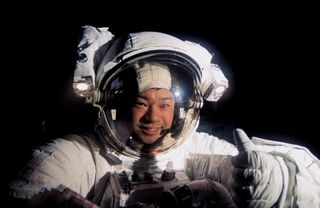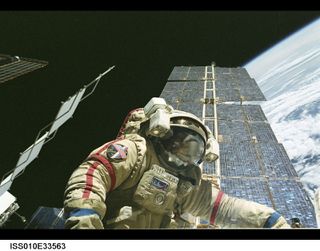Astronaut Leroy Chiao will discuss the value of the International Space Station in two online talks
Tune in to "The Virtual Astronaut" webcasts on Oct. 30 and Nov. 2 at 7 p.m. ET.

A highly experienced retired NASA astronaut will talk about the value of the International Space Station as an engineering feat, along with a cultural experience, in two online talks in the coming days.
Four-time spaceflyer Leroy Chiao will share his experiences during two talks broadcast as part of the Virtual Astronaut series, for which you can buy tickets here starting at $20.
The first of Chiao's talks will be a panel discussion on Friday (Oct. 30) at 7 p.m. EDT (Saturday, Oct. 31, 0000 GMT) discussing 20 years of continuous occupation on the International Space Station this fall. (Other participants on the panel include astronauts Jack Fischer, Susan Helms and Nicole Stott, and it will be moderated by collectSPACE's Robert Pearlman.) Chiao will also deliver an individual talk on working remotely on Monday (Nov. 2) at 7 p.m. EST (0100 GMT on Nov. 3).
Related: How Leroy Chiao turned his dream of space into a reality
"It's important that we continue to fully support efforts on the International Space Station, because it is a testing ground not only for life support systems, but also for research — specifically biomedical," Chiao told Space.com.
One of the biggest challenges for long-duration missions, he observed, is keeping astronauts healthy. Without lots of exercise and careful attention, astronauts can return home with vastly weakened bones, muscles and blood flow — and even at that, it usually takes months for a typical long-duration flyer to feel somewhat normal again.
The International Space Station (ISS) has tested various devices to assist in good health for spaceflyers, including the Interim Resistance Exercise Device (iRED) that helped astronauts simulate weight lifting in microgravity using resistive bands. (Today, the piston-driven Advanced Resistive Exercise Device or ARED takes iRED's place, since ARED offers tougher workouts to improve astronaut weight-lifting capabilities.)
Get the Space.com Newsletter
Breaking space news, the latest updates on rocket launches, skywatching events and more!
Chiao said his talk will discuss how the designers of iRED managed to pass safety checks from cautious NASA officials and international partners. Initially, he said, "the safety people said 'no way', because of the stored energy in those rubber bands — what if one of those let go?" But iRED stored the energy safely by using a stopper, to prevent the cord from suddenly retracting and causing injuries. Chiao used iRED himself in space and praised its capabilities: "It kept me healthy."

The astronaut's accumulated spaceflight experience includes three space shuttle flights (STS-65 in 1994, STS-72 in 1996 and STS-92 in 2000) along with the long-duration Expedition 10 mission (2004-2005). This repeated spaceflight work allowed Chiao to not only test tools and techniques for work on the ISS, but also to try them out for real during longer missions.
For example, Chiao said, spacewalk tests in STS-72 allowed astronauts to install cables on future spacewalks, something that long-duration crews routinely do today. A key piece of feedback his crew delivered was to make cables slightly longer, to make cables easier to install using clumsy (but necessary) extra-vehicular activity (EVA) or spacewalking gloves in microgravity.
STS-92 was the last visit to the space station before the Expedition 1 crew did a long-duration mission, starting the 20 years of continuous occupation on ISS, he added. "We installed a truss through EVAs and robotic operations … we got the place ready for the crew," he said. (Fellow STS-92 crewmate Pam Melroy did a talk for the Virtual Astronaut series on Oct. 24.)
Flying in space not only was a technical endeavor, but a cultural experience for Chiao. Chiao trained for 3.5 years for his long-duration mission, learning the Russian language to a high degree of technical expertise. He is one of a handful of spaceflyers who have done spacewalks in both the NASA Extravehicular Mobility Unit (EMU) suit and the Russian Orlan suit. There are advantages and disadvantages to both types of spacesuits and he was grateful for the experience, he said.
For example, the EMU is custom-built for each astronaut, unlike the Russian Orlan. The Orlan operates at a slightly higher pressure of 5.9 pounds per square inch (PSI) compared to the EMU (4.3), which lessens the time needed for "prebreathing" to remove nitrogen from the bloodstream ahead of donning the suit, he said. But the Orlan's higher operating pressure makes the Orlan a little stiffer for operations, Chiao added.
Related: From Apollo to Mars: The evolution of spacesuits

Another experience Chiao enjoyed was voting from space in the 2004 presidential election, which today's ISS American crew members will also do for the 2020 presidential election that ends Nov. 3. Chiao said the procedures haven't changed that much in two decades, and that the voting was very easy to do. "The voting registrar sent an encrypted Word file up to me in an email, through NASA. I opened it with a password; it was basically a ballot. I sent it back, and the person opened it and transcribed my vote."
Chiao's talks will also raise awareness to support the Houston Association for Space and Science Education, for whom he has been a spokesperson since 2012. Prior to the pandemic, the association flew children from around the world to Houston and Huntsville, Ala. to learn about space and astronaut training. Those programs are necessarily on hold because of the pandemic, but there is hope the experiences can one day resume.
Follow Elizabeth Howell on Twitter @howellspace. Follow us on Twitter @Spacedotcom and on Facebook.
Join our Space Forums to keep talking space on the latest missions, night sky and more! And if you have a news tip, correction or comment, let us know at: community@space.com.

Elizabeth Howell (she/her), Ph.D., is a staff writer in the spaceflight channel since 2022 covering diversity, education and gaming as well. She was contributing writer for Space.com for 10 years before joining full-time. Elizabeth's reporting includes multiple exclusives with the White House and Office of the Vice-President of the United States, an exclusive conversation with aspiring space tourist (and NSYNC bassist) Lance Bass, speaking several times with the International Space Station, witnessing five human spaceflight launches on two continents, flying parabolic, working inside a spacesuit, and participating in a simulated Mars mission. Her latest book, "Why Am I Taller?", is co-written with astronaut Dave Williams. Elizabeth holds a Ph.D. and M.Sc. in Space Studies from the University of North Dakota, a Bachelor of Journalism from Canada's Carleton University and a Bachelor of History from Canada's Athabasca University. Elizabeth is also a post-secondary instructor in communications and science at several institutions since 2015; her experience includes developing and teaching an astronomy course at Canada's Algonquin College (with Indigenous content as well) to more than 1,000 students since 2020. Elizabeth first got interested in space after watching the movie Apollo 13 in 1996, and still wants to be an astronaut someday. Mastodon: https://qoto.org/@howellspace
